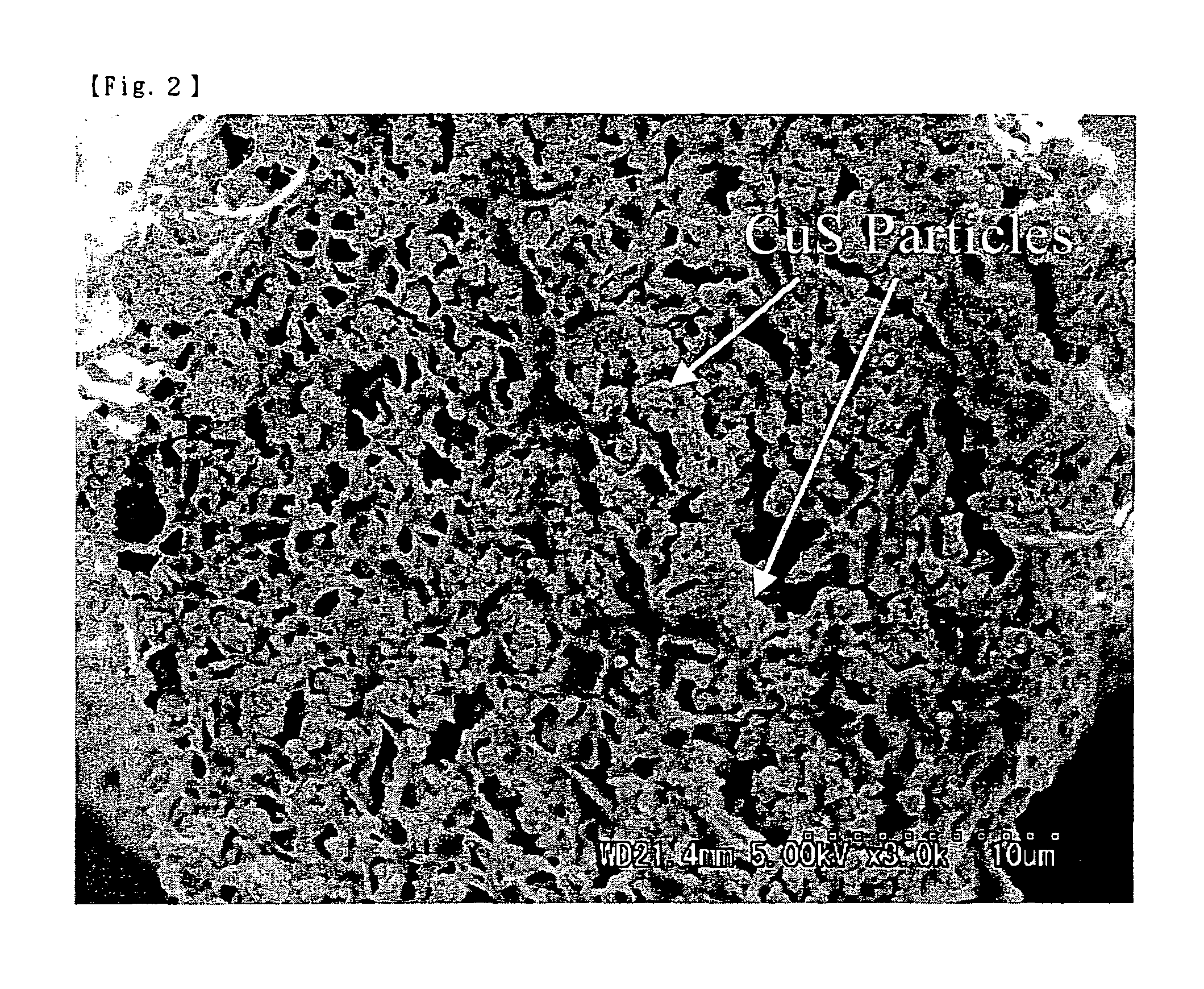Conductive polyvinyl alcohol fiber
a technology fiber, which is applied in the field of conductive polyvinyl alcohol, can solve the problems of poor mechanical properties of conductive cellulose fiber, high temperature inside the duplicator, and inability to meet the requirement, and achieve good conductivity and durability
- Summary
- Abstract
- Description
- Claims
- Application Information
AI Technical Summary
Benefits of technology
Problems solved by technology
Method used
Image
Examples
example 1
[0082](1) PVA having a degree of viscosity-average polymerization of 1700 and a degree of saponification of 99.8 mol % was added to DMSO to have a PVA concentration of 23% by mass, and dissolved under heat at 90° C. in a nitrogen atmosphere. Thus obtained, the spinning solution was spun in a mode of dry-wet spinning through a nozzle with 108 holes each having a hole diameter of 0.08 mm, into a coagulation bath of methanol / DMSO=70 / 30 (by mass) at 5° C.
[0083](2) The thus-solidified fiber was dipped in a second bath having the same methanol / DMSO composition as that of the coagulation bath, and then wet-drawn 6-fold in a methanol bath at 25° C. Next, this was led into a water bath at 25° C. containing 50 g / liter of copper acetate (by Wako Jun-yaku) dissolved therein, taking a residence time therein of 120 seconds, and then led into a water bath at 25° C. containing 50 g / liter of sodium sulfide (by Wako Jun-yaku) therein, taking a residence time therein of 120 seconds. Further, to preven...
example 2
[0086](1) The fiber obtained in the same dry-wet spinning process as in Example 1 was dried with hot air at 120° C., and then drawn in a hot-air fiber-drawing furnace at 235° C. up to an overall draw ratio (wet draw ratio×hot air furnace draw ratio) of 13 times.
[0087](2) Thus obtained, the fiber was led into a water bath at 25° C. containing 50 g / liter of copper acetate (by Wako Jun-yaku) dissolved therein, taking a residence time therein of 120 seconds, and then led into a water bath at 25° C. containing 50 g / liter of sodium sulfide (by Wako Jun-yaku) therein, taking a residence time therein of 120 seconds. This process repeated 4 times, and then the fiber was dried with hot air at 120° C.
[0088](3) The content of the copper sulfide nano-particles in the fiber obtained herein was 7.25% by mass; and the mean particle size of the particles was 8.0 nm. The degree of orientation of the fiber was 93%. The degree of swelling of the fiber in the bath was 60% by weight. The physical propert...
example 3
[0090]A fiber was obtained under the same spinning condition as in Example 1, for which, however, the copper acetate and sodium sulfide bath concentration was 5 g / liter. Thus obtained, the fiber was tested and evaluated, and its results are given in Table 1. The content of the copper sulfide nano-particles in the fiber obtained herein was 0.71% by mass; and the mean particle size of the particles was 5.0 nm. The degree of orientation of the fiber was 70%. The degree of swelling of the fiber in the bath was 200% by weight. The physical properties of the fiber were as follows: The single fiber fineness was 10.2 dtex; the fiber elasticity and tenacity were 100 cN / dtex and 4.5 cN / dtex, respectively; and the volume intrinsic resistivity of the fiber was 8.0×107 Ω·m. The fiber had a good outward appearance with no surface mottle. The fiber had good mechanical properties of ordinary PVA fibers and had good conductivity.
PUM
| Property | Measurement | Unit |
|---|---|---|
| mean particle size | aaaaa | aaaaa |
| volume intrinsic resistivity | aaaaa | aaaaa |
| residence time | aaaaa | aaaaa |
Abstract
Description
Claims
Application Information
 Login to View More
Login to View More - R&D
- Intellectual Property
- Life Sciences
- Materials
- Tech Scout
- Unparalleled Data Quality
- Higher Quality Content
- 60% Fewer Hallucinations
Browse by: Latest US Patents, China's latest patents, Technical Efficacy Thesaurus, Application Domain, Technology Topic, Popular Technical Reports.
© 2025 PatSnap. All rights reserved.Legal|Privacy policy|Modern Slavery Act Transparency Statement|Sitemap|About US| Contact US: help@patsnap.com



